The increasing adoption of solar energy as a sustainable power source has driven the need for efficient and reliable energy storage solutions. LiFePO4 battery has emerged as a leading choice for solar energy storage due to their superior safety, efficiency, and longevity. This article explores strategies to maximize solar energy storage harvest using LiFePO4 battery, covering design considerations, performance optimization, and real-world applications.

Introduction to LiFePO4 Battery
LiFePO4 battery is type of lithium-ion battery known for their stability and safety. Unlike other lithium-ion battery, LiFePO4 battery is less prone to thermal runaway, making them a safer option for energy storage. Their long cycle life and high efficiency make them particularly well-suited for solar energy storage applications.
Key Features of LiFePO4 Battery
- Safety: Superior thermal and chemical stability reduces the risk of overheating and fires.
- Long Cycle Life: Can endure thousands of charge-discharge cycles with minimal degradation.
- High Efficiency: Exhibits high charge and discharge efficiency, typically around 95%.
- Environmental Benefits: Made from non-toxic and abundant materials, reducing environmental impact.
Designing Solar Energy Storage Systems with LiFePO4 Battery
To maximize the harvest of solar energy storage using LiFePO4 battery, it is crucial to design the system with careful consideration of several factors.
Assessing Energy Needs
Understanding the energy requirements of the system is the first step. This includes analyzing peak demand periods, average daily consumption, and backup needs.
| Parameter | Value |
|---|---|
| Average Daily Usage | 50 kWh |
| Peak Demand | 15 kW |
| Backup Duration | 24 hours |
Sizing Solar Panels and LiFePO4 Battery
Determining the appropriate size of the solar panels and LiFePO4 battery is essential to meet the energy needs efficiently.
| Component | Specification |
|---|---|
| Solar Panel Capacity | 20 kW |
| LiFePO4 Battery Capacity | 100 kWh |
| Usable Battery Capacity | 80 kWh (80% DoD) |
Inverter and Charge Controller Selection
Choosing the right inverter and charge controller ensures optimal performance and compatibility with the solar panels and LiFePO4 battery.
| Component | Specification |
|---|---|
| Inverter Capacity | 20 kW |
| Charge Controller Type | MPPT |
| Charge Controller Capacity | 100 A |
Performance Optimization Strategies
To maximize the efficiency and longevity of solar energy storage with LiFePO4 battery, several optimization strategies can be implemented.
Implementing Advanced Battery Management Systems (BMS)
A robust BMS is essential for monitoring and controlling the operation of LiFePO4 battery, ensuring safety and efficiency. The BMS manages the charging and discharging processes, balances cell voltages, and protects against overcharging and overheating.
Utilizing Maximum Power Point Tracking (MPPT) Controllers
MPPT controllers optimize the power output from the solar panels by continuously adjusting the electrical operating point of the modules. This ensures that the maximum possible power is extracted from the solar panels and stored in the LiFePO4 battery.
Temperature Management
Maintaining optimal temperature conditions is crucial for maximizing the performance and lifespan of LiFePO4 battery. Implementing cooling or heating systems as needed can prevent the batteries from operating outside their ideal temperature range.
Real-World Applications and Case Studies
Residential Solar Energy Storage
A residential solar energy storage system in California uses a 10 kW solar panel array and a 40 kWh LiFePO4 battery. The system provides the following benefits:
- Energy Independence: Reduces reliance on grid electricity by 70%.
- Cost Savings: Saves approximately $2,000 annually on electricity bills.
- Backup Power: Provides reliable backup power during outages.
| Parameter | Value |
|---|---|
| Solar Panel Capacity | 10 kW |
| LiFePO4 Battery Capacity | 40 kWh |
| Annual Savings | $2,000 |
Commercial Solar Energy Storage
A commercial building in Texas implemented a solar energy storage system with a 50 kW solar panel array and a 200 kWh LiFePO4 battery. The system demonstrated significant improvements in energy efficiency and cost savings:
- Peak Shaving: Reduces peak demand charges by 50%.
- Energy Savings: Saves $20,000 annually on electricity bills.
- Environmental Impact: Reduces carbon footprint by 30%.
| Parameter | Value |
|---|---|
| Solar Panel Capacity | 50 kW |
| LiFePO4 Battery Capacity | 200 kWh |
| Annual Savings | $20,000 |
Utility-Scale Solar Energy Storage
A utility-scale solar energy storage system in Arizona incorporates a 500 kW solar panel array and a 1,000 kWh LiFePO4 battery. The system supports grid stability and renewable energy integration:
- Grid Stabilization: Provides frequency regulation and peak shaving.
- Renewable Integration: Enhances the integration of renewable energy sources into the grid.
- Cost Reduction: Saves $100,000 annually on operational costs.
| Parameter | Value |
|---|---|
| Solar Panel Capacity | 500 kW |
| LiFePO4 Battery Capacity | 1,000 kWh |
| Annual Savings | $100,000 |
Future Prospects and Innovations
The future of solar energy storage with LiFePO4 battery looks promising, with several ongoing innovations aimed at further enhancing their efficiency and cost-effectiveness.
Improved Energy Density
Research is focused on increasing the energy density of LiFePO4 battery, making them more competitive with other high-density lithium-ion battery. This improvement will allow for smaller, lighter batteries with the same storage capacity.
Advanced Manufacturing Techniques
Innovations in manufacturing processes are expected to reduce the cost of producing LiFePO4 battery, making them more affordable for a broader range of applications. Techniques such as automation and the use of advanced materials can lower production costs.
Enhanced Recycling Processes
Developing efficient recycling processes for LiFePO4 battery will improve their environmental sustainability by recovering valuable materials and reducing waste. Advanced recycling technologies can also lower the overall cost of battery production.
Conclusion
Maximizing solar energy storage harvest with LiFePO4 battery involves careful design, performance optimization, and the implementation of advanced technologies. The superior safety, efficiency, and longevity of LiFePO4 battery make them an ideal choice for residential, commercial, and utility-scale solar energy storage systems. By leveraging these advantages and adopting innovative strategies, users can achieve significant cost savings, enhance energy independence, and contribute to environmental sustainability.
